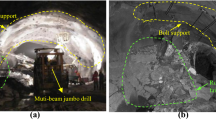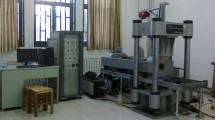Abstract
Shear behavior of the bolt–grout interface basically depends on site-specific boundary conditions, i.e., initial normal stress and normal stiffness of the borehole wall. Few studies have been conducted to investigate the shear behaviors between the bolt and grout material under different boundary conditions. To better understand the effect of boundary conditions on the shear behaviors of the bolt–grout interface, simplified two-dimensional (2D) bolt–grout interface specimens are prepared and tested using direct shear tests at various initial normal stresses and normal stiffnesses in this context. The testing results showed that both initial normal stress and normal stiffness significantly influence the bolt–grout interface shearing behaviors. Increasing the normal stiffness or initial normal stress would increase the peak and residual shear strength. However, the degree of the brittleness after the peak, normal displacement, and peak friction coefficient was reduced. It is noted that the peak and residual shear strength points under the constant normal stiffness conditions located near the peak and residual strength envelopes for the constant normal load tests, respectively. Besides, the shear failure process of the bolt–grout interface was captured by PAC acoustic emission (AE) monitoring and digital camera technology, a good correlation between the evolution of AE parameters and the shear stress curves was obtained.










Similar content being viewed by others
Abbreviations
- 2D:
-
Two-dimensional
- CNL:
-
Constant normal load
- CNS:
-
Constant normal stiffness
- AE:
-
Acoustic emission
- UCS:
-
Uniaxial compressive strength
- σ n0 :
-
Initial normal stress applied on the bolt–grout interface
- k n :
-
Normal stiffness applied on the bolt–grout interface
- σ :
-
Normal stress on the bolt–grout interface
- v :
-
Normal displacement of the bolt–grout interface
- R 2 :
-
Coefficient of determination of the fitting curve
References
Aziz N, Dey A, Indraratna B (2001) New approach to study load transfer mechanisms of fully grouted bolts. In: Proceedings of 17th international mining congress and exhibition in Turkey, the chamber of mining engineers of turkey. Ankara, pp 143–154
Aziz N, Jalalifar H, Remennikov AM, Sinclair S, Green A (2008) Optimisation of the bolt profile configuration for load transfer enhancement. In: Coal operators’ conference. Wollongong, pp 125–131
Aziz N, Mirza A, Nemick J (2016) Load transfer characteristics of plain and spiral cable bolts tested in new non rotating pull testing apparatus. In: Coal operators’ conference. Wollongong, pp 32–39
Benmokrane B, Mouchaorab KS, Ballivy G (1994) Laboratory investigation of shaft resistance of rock-socketed piers using the constant normal stiffness direct shear test. Can Geotech J 31(3):407–419
Cai Y, Jiang YJ, Esaki T (2004) A study of rock bolting design in soft rock. Int J Rock Mech Min Sci 41(3):1–6
Cao C (2013) Bolt profile configuration and load transfer capacity optimisation. Ph.D. Dissertation, University of Wollongong
Cao C, Ren T, Cook C (2013) Calculation of the effect of Poisson’s ratio in laboratory push and pull testing of resin-encapsulated bolts. Int J Rock Mech Min Sci 64:175–180
Chen JH, Hagan P, Saydam S (2016) Load transfer behavior of fully grouted cable bolts reinforced in weak rocks under tensile loading conditions. Geotech Test J 39(2):252–263
Chen JH, Hagan P, Saydam S (2018) A new laboratory short encapsulation pull test for investigating load transfer behavior of fully grouted cable bolts. Geotech Test J 41(3):435–447
Gu XF, Seidel JP, Haberfield CM (2003) Direct shear test of sandstone-concrete joints. Int J Geomech 3(1):21–33
Hyett AJ, Bawden WF, Reichert RD (1992) The effect of rock mass confinement on the bond strength of fully grouted cable bolts. Int J Rock Mech Min Sci 29(5):503–524
Hyett AJJ, Bawden WFF, Macsporran GRR, Moosavi M (1995) A constitutive law for bond failure of fully-grouted cable bolts using a modified hoek cell. Int J Rock Mech Min Sci 32(1):11–36
Indraratna B, Haque A (2000) Experimental and numerical modeling of shear behaviour of rock joints. In: GeoEng 2000, An international conference on geotechnical & geological engineering. Pennsylvania, USA
Indraratna B, Haque A, Aziz N (1998) Laboratory modelling of shear behaviour of soft joints under constant normal stiffness conditions. Geotech Geol Eng 16(1):17–44
Jalalifar H (2006) A new approach in determining the load transfer mechanism in fully grouted bolts. Ph.D. Dissertation, University of Wollongong
Jiang YJ, Li B, Tanabashi Y (2006) Estimating the relation between surface roughness and mechanical properties of rock joints. Int J Rock Mech Min Sci 43(6):837–846
Jiang YJ, Wu XZ, Wang G, Li SC, Wang Q, Cai Y (2016) Bond strength test methods for the bolt-grout-surrounding rock. 28:1–7. (in Chinese)
Li CC (2012) Performance of D-bolts under static loading. Rock Mech Rock Eng 45(2):183–192
Li CC, Kristjansson G, Høien AH (2016) Critical embedment length and bond strength of fully encapsulated rebar rockbolts. Tunn Undergr Sp Technol 59:16–23
Ma SQ, Nemcik J, Aziz N (2013) An analytical model of fully grouted rock bolts subjected to tensile load. Constr Build Mater 49:519–526
Maksimović M (1992) New description of the shear strength for rock joints. Rock Mech Rock Eng 25(4):275–284
Martin LB (2012) Theoretical and experimental study of fully grouted rockbolts and cablebolts under axial loads. Ph.D. Dissertation, Ecole Nationale Supérieure des Mines de Paris
Meng F, Zhou H, Wang Z, Zhang LM, Kong L, Li SJ, Zhang CQ (2017) Influences of shear history and infilling on the mechanical characteristics and acoustic emissions of joints. Rock Mech Rock Eng 50(8):2039–2057
Moosavi M, Bawden W, Hyett A (2002) Mechanism of bond failure and load distribution along fully grouted cable-bolts. Min Technol 111(1):1–12
Moosavi M, Jafari A, Khosravi A (2005) Bond of cement grouted reinforcing bars under constant radial pressure. Cem Concr Compos 27(1):103–109
Poturovic S, Schubert W, Blümel M (2015) Comparison of constant normal load (CNL) and constant normal stiffness (CNS) direct shear tests. In: ISRM regional symposium-EUROCK 2015. International Society for Rock Mechanics, pp 445–450
Salcher M, Bertuzzi R (2018) Results of pull tests of rock bolts and cable bolts in Sydney sandstone and shale. Tunn Undergr Sp Technol 74:60–70
Seidel JP, Haberfield CM (2002) Laboratory testing of concrete-rock joints in constant normal stiffness direct shear. Geotech Test J 25(4):391–404
Shrivastava AK, Rao KS (2018) Physical modeling of shear behavior of infilled rock joints under CNL and CNS boundary conditions. Rock Mech Rock Eng 51(1):101–118
Stille H, Holmberg M, Nord G (1989) Support of weak rock with grouted bolts and shotcrete. Int J Rock Mech Min Sci 26(1):99–113
Thenevin I, BlancoMartín L, HadjHassen F, Schleifer J, Lubosik Z, Wrana A (2017) Laboratory pull-out tests on fully grouted rock bolts and cable bolts: results and lessons learned. J Rock Mech Geotech Eng 9(5):843–855
Thirukumaran S, Indraratna B (2016) A review of shear strength models for rock joints subjected to constant normal stiffness. J Rock Mech Geotech Eng 8(3):405–414
Villaescusa E, Varden R, Hassell R (2008) Quantifying the performance of resin anchored rock bolts in the Australian underground hard rock mining industry. Int J Rock Mech Min Sci 45(1):94–102
Yokota Y, Zhao ZY, Nie W, Date K, Iwano K, Okada Y (2018) Experimental and numerical study on the interface behaviour between the rock bolt and bond material. Rock Mech Rock Eng 52(3):1–11
Zhang CQ, Cui GJ, Zhou H, Liu LP, Liu ZJ, Lu JJ, Cheng GT (2018) Experimental study on shear and deformation characteristics of the rod-grout interface. Chin J Rock Mech Eng 37(4):820–828 (in Chinese)
Acknowledgements
This work is supported by the Key projects of the Yalong River Joint Fund of the National Natural Science Foundation of China (U1865203) and the National Natural Science Foundation of China (51279201). The partial support from the Youth Innovation Promotion Association CAS is gratefully acknowledged.
Author information
Authors and Affiliations
Corresponding author
Ethics declarations
Conflict of interest
The proper acknowledgments to other works have been given. All of the authors that appear on the submission declare no conflict of interests in the submitted manuscripts and consent to submit. And they have contributed significantly to the work submitted.
Additional information
Publisher's Note
Springer Nature remains neutral with regard to jurisdictional claims in published maps and institutional affiliations.
Rights and permissions
About this article
Cite this article
Zhang, C., Cui, G., Deng, L. et al. Laboratory Investigation on Shear Behaviors of Bolt–Grout Interface Subjected to Constant Normal Stiffness. Rock Mech Rock Eng 53, 1333–1347 (2020). https://doi.org/10.1007/s00603-019-01983-6
Received:
Accepted:
Published:
Issue Date:
DOI: https://doi.org/10.1007/s00603-019-01983-6




